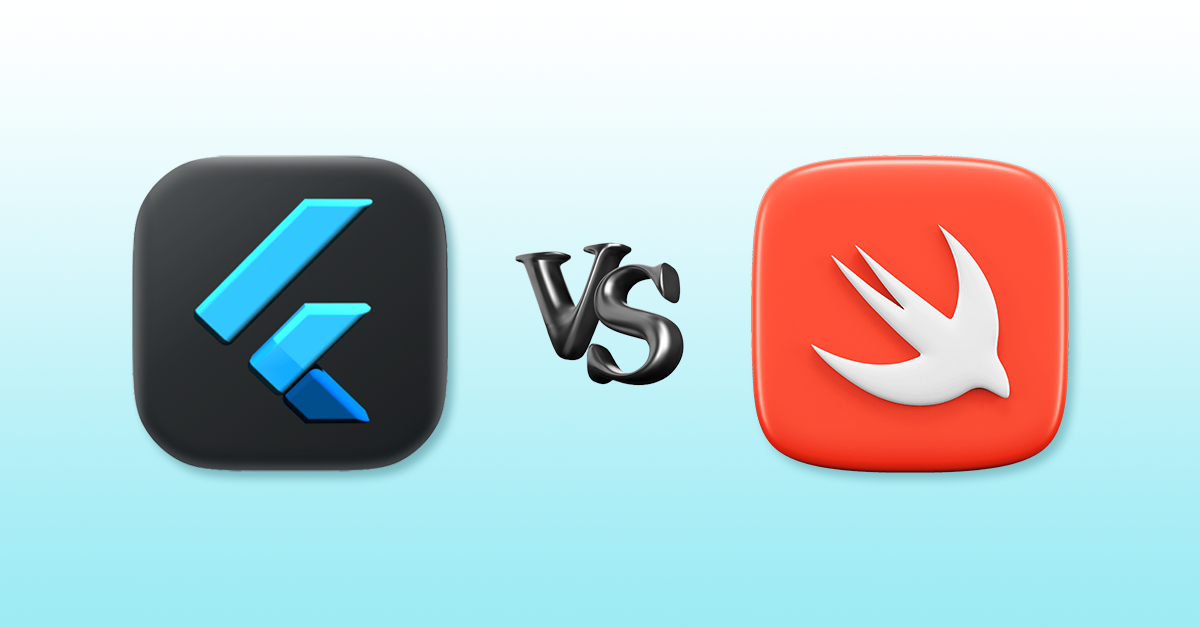It is no surprise that iOS application development is becoming increasingly popular. With the rise of mobile technology, more and more people are turning to their phones for everyday tasks such as shopping, banking, communication and entertainment. This has necessitated a need for businesses to develop apps that cater to these needs. The question then becomes: which technology should you use to build your app? Flutter Or Swift. Flutter, Google’s open-source UI software development kit, has gained traction for its versatility and speed. On the other hand, Swift, birthed by Apple itself, prides itself on performance and its tight-knit integration with the Apple ecosystem. Both have their loyalists, both have their strengths. Here we will delve deep into the contrasts, comparing their features, performance, and ease of use, helping you make an informed decision for your next iOS project.
Overview of Flutter
Flutter is a powerful and innovative open-source UI software development kit created by Google. It allows developers to build high-quality native applications for iOS, Android, web, and desktop from a single codebase. The key advantage of Flutter is its ability to provide a fast and smooth user experience across different platforms.
One of the standout features of Flutter is its hot reload functionality, which enables developers to see instant changes in their code without having to restart the application. This greatly speeds up the development process and enhances productivity.
Flutter uses Dart as its programming language, which is easy to learn even for those who are new to mobile app development. With its rich set of pre-designed widgets and customizable UI components, Flutter makes it simple for developers to create visually appealing interfaces that meet the specific needs of their users.
Overview of Swift
Swift is a modern and powerful programming language developed by Apple for iOS, macOS, watchOS, and tvOS app development. It was introduced in 2014 as a replacement for Objective-C and has gained popularity among developers due to its simplicity and readability.
One of the key features of Swift is its safety. It provides compile-time checking that helps identify and prevent common errors before they occur during runtime. This ensures that your code is more reliable and less prone to crashes or bugs.
Another advantage of using Swift is its performance. It uses advanced optimization techniques to deliver faster execution speed compared to other languages like Objective-C. This makes it ideal for building high-performance applications that require quick response times.
Flutter vs Swift: Development Process
When it comes to the development process, both Flutter and Swift have their own advantages.
In terms of Flutter, one of its key strengths lies in its hot-reload feature. This allows developers to instantly see the changes they make in real-time, without having to rebuild the entire application. This can greatly speed up the development process and enhance productivity.
On the other hand, Swift offers seamless integration with Apple’s ecosystem. As a native language for iOS app development, Swift provides access to all of Apple’s frameworks and APIs. This makes it easier for developers to leverage existing resources and create apps that seamlessly integrate with other iOS features.
Furthermore, both Flutter and Swift offer robust testing capabilities. With Flutter’s built-in testing framework called “flutter_test”, developers can write unit tests as well as widget tests to ensure app functionality is working as expected. Similarly, Swift provides an XCTest framework which enables developers to write comprehensive test cases for their applications.
While Flutter excels in terms of quick iterations through its hot-reload feature, Swift offers excellent integration with Apple’s ecosystem. The choice between these two will ultimately depend on your specific project requirements and preferences as a developer
Flutter vs Swift: Performance
When it comes to performance, both Flutter and Swift have their strengths and weaknesses.
Flutter is known for its fast rendering capabilities. It uses Skia Graphics Library to render UI elements directly on the screen, which helps in achieving smooth animations and transitions. Additionally, Flutter’s hot reload feature allows developers to see the changes instantly without restarting the application, making the development process faster.
On the other hand, Swift is also designed with performance in mind. Being a compiled language, it offers excellent execution speed as compared to interpreted languages like JavaScript. With Swift’s static typing and advanced compiler optimizations, developers can write code that runs efficiently on iOS devices.
However, when it comes to app size and startup time, Flutter may not perform as well as Swift. Since Flutter apps require an additional runtime called Dart VM for execution, they tend to be larger in size and take longer to start up compared to native iOS apps written in Swift.
In conclusion (not conclusive), while both Flutter and Swift offer good performance for iOS app development, your choice depends on your specific requirements. If you prioritize smooth animations and rapid development cycles with hot reload functionality but don’t mind slightly larger app sizes or slower startup times then flutter might be suitable.
Flutter vs Swift: UI and Design
Flutter allows developers to create visually stunning user interfaces with its built-in Material Design and Cupertino widgets. These widgets are customizable and provide a native-like experience on iOS devices. With Flutter’s hot reload feature, developers can quickly make changes to the UI in real time, making the design process more efficient.
On the other hand, Swift provides a powerful set of tools for designing interfaces using Interface Builder. It offers a wide range of pre-built components that can be easily customized to match the desired look and feel of an iOS application. Moreover, Swift supports Auto Layout, which simplifies the process of creating responsive layouts that adapt to different screen sizes.
Both Flutter and Swift have their strengths when it comes to UI and design. The choice between them ultimately depends on your specific requirements and preferences as a developer or designer
In need of skilled developers to create or expand your mobile product?
Flutter vs Swift: Community and Support
Community and support play a crucial role in the success of any programming language or framework. Flutter, backed by Google, has been gaining popularity rapidly since its launch. It has a strong and active community that constantly contributes to its growth. The Flutter community is known for being supportive and helpful, offering assistance through various online forums, such as Stack Overflow and Reddit. Additionally, there are numerous blogs, tutorials, videos, and documentation available that make learning Flutter easier for beginners.
On the other hand, Swift also boasts a dedicated community of developers who actively contribute to its development. Since Apple created Swift specifically for iOS app development, it naturally enjoys strong backing from the Apple developer community. There are plenty of resources available on various platforms like GitHub and Swift Forums where developers can find solutions to their queries.
Both communities continuously update frameworks with new features based on user feedback and demands which ensures ongoing improvements in performance and stability.
In terms of support from official sources – Google provides comprehensive documentation for Flutter development while Apple offers extensive documentation along with official guides for using Swift in iOS app development.
Both Flutter and Swift have thriving communities that provide ample support to developers at different stages of their journey
Flutter vs Swift: Use Cases
Flutter and Swift are two popular options for iOS application development, each with its own unique strengths and use cases. Let’s explore the use cases for both platforms.
Flutter is known for its cross-platform capabilities, allowing developers to build applications that can run on multiple platforms with a single codebase. This makes it a great choice for companies looking to develop apps for both iOS and Android simultaneously.
Additionally, Flutter excels in building highly customized user interfaces (UI) and delivering smooth animations. It offers a rich set of pre-built UI components and widgets, making it easier to create visually appealing apps quickly.
On the other hand, Swift is specifically designed by Apple for iOS app development. It offers excellent performance and compatibility with Apple’s ecosystem. Swift allows developers to access native APIs seamlessly, which is essential when working on complex projects that require deep integration with the iOS platform.
Swift is often preferred by enterprises or individuals who prioritize native app experiences or need access to specific features only available on iOS devices.
The choice between Flutter and Swift depends on your project requirements and priorities. If you’re focused on cross-platform development or want extensive customization options, Flutter might be the way to go. However, if you value native experience or have specific needs within the Apple ecosystem, then Swift would be more suitable.
Which is best for iOS Application Development?
When it comes to iOS application development, the choice between Flutter and Swift can be a tough one. Both frameworks have their own strengths and weaknesses, making it important to consider your specific needs before making a decision.
Flutter, with its cross-platform capabilities, allows developers to write code once and deploy it on both iOS and Android platforms. This can save time and resources for companies looking to reach a wider audience. Additionally, Flutter offers a rich set of pre-built UI components that make app development faster and more efficient.
On the other hand, Swift is Apple’s native programming language for iOS app development. It provides direct access to all of Apple’s frameworks and APIs, allowing developers to take full advantage of the platform’s features. With its strong performance and stability, Swift is often favored by large enterprises or organizations with complex applications.
The best choice for iOS application development depends on your specific requirements. If you are looking for cross-platform compatibility or need rapid prototyping capabilities, Flutter might be the way to go. However, if you prioritize seamless integration with Apple’s ecosystem or require advanced functionality specific to iOS devices, then Swift would be the better option.
Final Words
In the showdown between Flutter Vs Swift for iOS application development, it’s clear that both frameworks bring a unique set of strengths to the table. Flutter offers the allure of cross-platform development with a single codebase, making it a tempting choice for businesses looking to expand across different platforms. Swift, with its deep integration into the Apple ecosystem, ensures optimized performance and a native feel that’s hard to rival. Ultimately, the decision between Flutter and Swift hinges on your app’s specific needs and your priorities. Consulting with a leading Flutter app development Company can provide clarity and guide your Flutter project according to your unique requirements.
FAQs
Flutter and iOS are two different platforms, so it is not possible to say definitively which one is “better”. However, Flutter has some advantages over iOS, such as its cross-platform capabilities and its hot reload feature.
Yes, you can use Flutter for iOS development. Flutter is a cross-platform framework, which means that you can use it to develop apps for both iOS and Android.
Flutter and Swift are not similar programming languages. Flutter is written in Dart, while Swift is written in Swift. However, both Flutter and Swift are used to develop iOS apps.
Swift and Flutter are both powerful programming languages and frameworks. The best choice for you will depend on your specific needs and preferences. If you are looking for a cross-platform framework with hot reload, then Flutter is a good choice. If you are looking for a native iOS framework with a large community and support, then Swift is a good choice.















